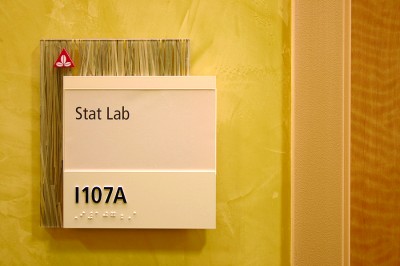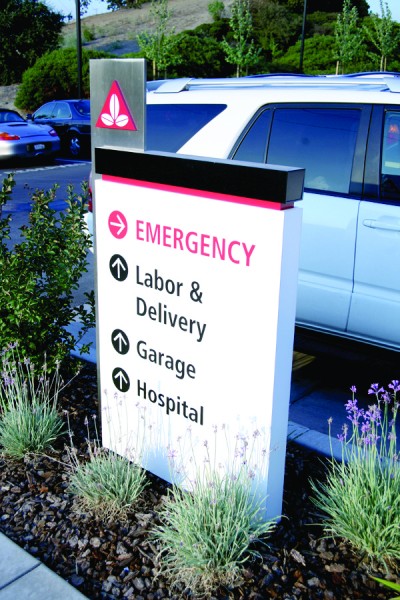Simpler signage
Even with such a wayfinding mix, signs will remain the single most pervasive way to provide directions in health-care environments.
When a patient arrives at the facility, especially, signs become the most important guide for their journey, from start to finish. Unfortunately, in an attempt to provide all of the information a visitor needs, most health-care facilities’ signs are too crowded with details and often provide them at the wrong locations. When directions are offered to virtually any place a patient might need to go, too early in his/her journey, they only add to the confusion.
One alternative concept is ‘progressive disclosure,’ i.e. providing only the information needed to direct the patient to the next decision point. This concept is already used very effectively in large airports, where visitors are guided in increments—first to the correct parking lot, then to the terminal, then to the concourse and finally to the gate.
In most health-care environments, progressive disclosure requires rethinking the way destinations are identified. Alphanumeric designations might be used to label departments or buildings, rather than specific names and functions. Then, as patients get closer to their destinations, additional alphanumeric can be provided to designate floors and rooms.
This concept has largely been ignored in the design of health-care facilities because they are not organized linearly like airports, but it can nevertheless become a fundamental component in planning and help simplify communications. By requiring fewer instructions to be viewed on each sign and remembered, more space opens up on those signs for larger type, meaning greater legibility.

Many health-care facilities have requirements for signs to comply with local codes, ordinances and life-safety regulations.
Designing a sign system
For a health-care signage system to function effectively, a number of orientation issues must be clear, including paths of travel, preferred routes, the designation of destinations, common language and the hierarchy of sign types within the system. All of these factors need to be considered before planning how directions will be given.
Common language
The language of health care can be confusing. ‘Ophthalmology’ and most other medical terms have little meaning to most people, so when they are used to designate destinations, they only create confusion. A user-friendly term like ‘eye care’ will make it much easier for visitors to know where to go.
Inconsistency of terms within a single facility can also add communications problems. If a patient is instructed to go to the X-ray, but the sign says ‘Radiology,’ uncertainty is created.
While these concerns may seem simple to address, there needs to be consensus-building among many stakeholders before a health-care organization can adopt and embrace common language. This process needs to happen before committing to the vocabulary of a sign program.
Graphic symbols can be even more common, visually representing care processes and the parts of the body being treated in a way multilingual users can all understand.
Hierarchy
A comprehensive sign system for a health-care facility may include as many as 50 different categories of signs, from outdoor monuments to room numbers. Each type needs to be designed to accommodate the necessary information in a legible way, which involves attention to scale, type size, fonts, spacing and borders appropriate to viewing distance, illumination, colour contrast and orientation of arrows.
The proper locations and placements are also important to the effectiveness of signs. Sightlines, height from the ground, orientation to paths of travel and relationship to the destination will all influence how information is presented.
Esthetics
Signage contributes to a facility’s character and quality, complementing architecture and interior design. Visual vibrancy and playfulness in a children’s hospital may contrast with subdued elegance in a senior-care facility. The appropriate expression of form, colours, typography and materials will shape a positive experience for the visitor.
Operations
The efficacy of a sign system is an ongoing matter. While the design must accommodate the initial budget, there will also be life-cycle costs, maintenance, cleaning, repair, replacement and other practical considerations for long-term viability.
Also, as mentioned, the dynamic nature of health-care facilities means continual change. So, sign systems should be designed for efficient, cost-effective and timely updates as needed.
Given the significant costs of implementing a comprehensive program, it is imperative for hospital managers to look at wayfinding as an investment. After all, research indicates the cost of poor wayfinding can be even higher, with money wasted by missed appointments and by staff spending valuable time showing patients where to go, along with a negative impact on the facility’s reputation.
Compliance
Many health-care facilities have distinct requirements for compliance with local codes, ordinances and life-safety regulations, which are important considerations when planning and designing signs. A facility that does not meet these requirements will not get its operating permits.






